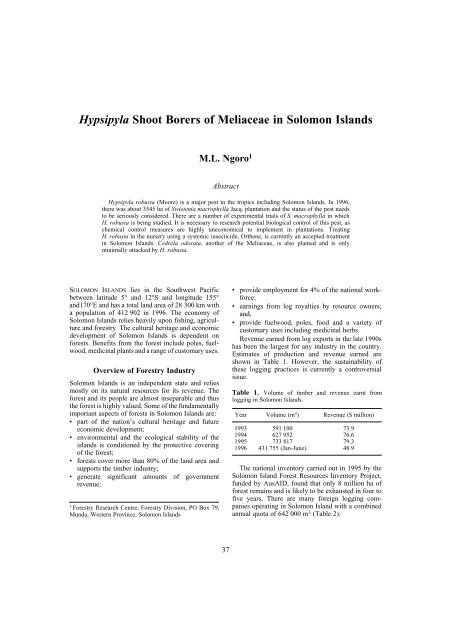Hypsipyla Shoot Borers of Meliaceae in Sri Lanka - Australian ...
Hypsipyla Shoot Borers of Meliaceae in Sri Lanka - Australian ...
Hypsipyla Shoot Borers of Meliaceae in Sri Lanka - Australian ...
Create successful ePaper yourself
Turn your PDF publications into a flip-book with our unique Google optimized e-Paper software.
<strong>Hypsipyla</strong> <strong>Shoot</strong> <strong>Borers</strong> <strong>of</strong> <strong>Meliaceae</strong> <strong>in</strong> Solomon Islands<br />
M.L. Ngoro 1<br />
Abstract<br />
<strong>Hypsipyla</strong> robusta (Moore) is a major pest <strong>in</strong> the tropics <strong>in</strong>clud<strong>in</strong>g Solomon Islands. In 1996,<br />
there was about 3545 ha <strong>of</strong> Swietenia macrophylla Jacq. plantation and the status <strong>of</strong> the pest needs<br />
to be seriously considered. There are a number <strong>of</strong> experimental trials <strong>of</strong> S. macrophylla <strong>in</strong> which<br />
H. robusta is be<strong>in</strong>g studied. It is necessary to research potential biological control <strong>of</strong> this pest, as<br />
chemical control measures are highly uneconomical to implement <strong>in</strong> plantations. Treat<strong>in</strong>g<br />
H. robusta <strong>in</strong> the nursery us<strong>in</strong>g a systemic <strong>in</strong>secticide, Orthene, is currently an accepted treatment<br />
<strong>in</strong> Solomon Islands. Cedrela odorata, another <strong>of</strong> the <strong>Meliaceae</strong>, is also planted and is only<br />
m<strong>in</strong>imally attacked by H. robusta.<br />
SOLOMON ISLANDS lies <strong>in</strong> the Southwest Pacific<br />
between latitude 5° and 12°S and longitude 155°<br />
and170°E and has a total land area <strong>of</strong> 28 300 km with<br />
a population <strong>of</strong> 412 902 <strong>in</strong> 1996. The economy <strong>of</strong><br />
Solomon Islands relies heavily upon fish<strong>in</strong>g, agriculture<br />
and forestry. The cultural heritage and economic<br />
development <strong>of</strong> Solomon Islands is dependent on<br />
forests. Benefits from the forest <strong>in</strong>clude poles, fuelwood,<br />
medic<strong>in</strong>al plants and a range <strong>of</strong> customary uses.<br />
Overview <strong>of</strong> Forestry Industry<br />
Solomon Islands is an <strong>in</strong>dependent state and relies<br />
mostly on its natural resources for its revenue. The<br />
forest and its people are almost <strong>in</strong>separable and thus<br />
the forest is highly valued. Some <strong>of</strong> the fundamentally<br />
important aspects <strong>of</strong> forests <strong>in</strong> Solomon Islands are:<br />
• part <strong>of</strong> the nation’s cultural heritage and future<br />
economic development;<br />
• environmental and the ecological stability <strong>of</strong> the<br />
islands is conditioned by the protective cover<strong>in</strong>g<br />
<strong>of</strong> the forest;<br />
• forests cover more than 80% <strong>of</strong> the land area and<br />
supports the timber <strong>in</strong>dustry;<br />
• generate significant amounts <strong>of</strong> government<br />
revenue;<br />
1 Forestry Research Centre, Forestry Division, PO Box 79,<br />
Munda, Western Prov<strong>in</strong>ce, Solomon Islands<br />
37<br />
• provide employment for 4% <strong>of</strong> the national workforce;<br />
• earn<strong>in</strong>gs from log royalties by resource owners;<br />
and,<br />
• provide fuelwood, poles, food and a variety <strong>of</strong><br />
customary uses <strong>in</strong>clud<strong>in</strong>g medic<strong>in</strong>al herbs.<br />
Revenue earned from log exports <strong>in</strong> the late 1990s<br />
has been the largest for any <strong>in</strong>dustry <strong>in</strong> the country.<br />
Estimates <strong>of</strong> production and revenue earned are<br />
shown <strong>in</strong> Table 1. However, the susta<strong>in</strong>ability <strong>of</strong><br />
these logg<strong>in</strong>g practices is currently a controversial<br />
issue.<br />
Table 1. Volume <strong>of</strong> timber and revenue earnt from<br />
logg<strong>in</strong>g <strong>in</strong> Solomon Islands.<br />
Year Volume (m 3 ) Revenue ($ million)<br />
1993 591 100 73.9<br />
1994 627 952 76.6<br />
1995 733 817 79.3<br />
1996 431 755 (Jan-June) 48.9<br />
The national <strong>in</strong>ventory carried out <strong>in</strong> 1995 by the<br />
Solomon Island Forest Resources Inventory Project,<br />
funded by AusAID, found that only 8 million ha <strong>of</strong><br />
forest rema<strong>in</strong>s and is likely to be exhausted <strong>in</strong> four to<br />
five years. There are many foreign logg<strong>in</strong>g companies<br />
operat<strong>in</strong>g <strong>in</strong> Solomon Island with a comb<strong>in</strong>ed<br />
annual quota <strong>of</strong> 642 000 m 3 (Table 2).

















